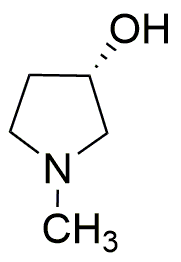(S)-(+)-1-Methyl-3-pyrrolidinol is widely utilized in research focused on
- Pharmaceutical Development: This compound serves as a key intermediate in the synthesis of various pharmaceuticals, particularly in the development of drugs targeting the central nervous system. Its unique structure allows for enhanced bioactivity compared to other similar compounds.
- Chiral Catalysis: It is used as a chiral catalyst in asymmetric synthesis, helping researchers create enantiomerically pure compounds. This is crucial in the production of many drugs where the specific orientation of molecules can significantly impact efficacy.
- Flavor and Fragrance Industry: The compound is also applied in the formulation of flavors and fragrances, providing a distinctive scent profile that enhances consumer products such as perfumes and food additives.
- Material Science: In polymer chemistry, it is utilized as a building block for creating specialty polymers with unique properties, which can be tailored for specific applications in coatings and adhesives.
- Research in Neuroscience: Its role in neuroscience research is significant, as it is studied for its potential effects on neurotransmitter systems, offering insights into the development of treatments for neurological disorders.
Informations générales
Propriétés
Sécurité et réglementation
Applications
(S)-(+)-1-Methyl-3-pyrrolidinol is widely utilized in research focused on
- Pharmaceutical Development: This compound serves as a key intermediate in the synthesis of various pharmaceuticals, particularly in the development of drugs targeting the central nervous system. Its unique structure allows for enhanced bioactivity compared to other similar compounds.
- Chiral Catalysis: It is used as a chiral catalyst in asymmetric synthesis, helping researchers create enantiomerically pure compounds. This is crucial in the production of many drugs where the specific orientation of molecules can significantly impact efficacy.
- Flavor and Fragrance Industry: The compound is also applied in the formulation of flavors and fragrances, providing a distinctive scent profile that enhances consumer products such as perfumes and food additives.
- Material Science: In polymer chemistry, it is utilized as a building block for creating specialty polymers with unique properties, which can be tailored for specific applications in coatings and adhesives.
- Research in Neuroscience: Its role in neuroscience research is significant, as it is studied for its potential effects on neurotransmitter systems, offering insights into the development of treatments for neurological disorders.
Documents
Fiches de données de sécurité (FDS)
La FDS fournit des informations de sécurité complètes sur la manipulation, le stockage et l’élimination du produit.
Spécifications du produit (PS)
Le PS fournit une description complète des propriétés du produit, notamment sa composition chimique, son état physique, sa pureté et les exigences de stockage. Il détaille également les plages de qualité acceptables et les applications prévues du produit.
Certificats d'analyse (COA)
Recherchez des certificats d'analyse (COA) en saisissant le numéro de lot du produit. Les numéros de lot et de lot se trouvent sur l'étiquette d'un produit, après les mots « Lot » ou « Lot de fabrication ».
Numéro de catalogue
Numéro de lot/série
Certificats d'origine (COO)
Ce certificat d'exploitation confirme le pays dans lequel le produit a été fabriqué, et détaille également les matériaux et composants utilisés et s'il est issu de sources naturelles, synthétiques ou autres sources spécifiques. Ce certificat peut être requis pour les douanes, le commerce et la conformité réglementaire.
Numéro de catalogue
Numéro de lot/série
Fiches de données de sécurité (FDS)
La FDS fournit des informations de sécurité complètes sur la manipulation, le stockage et l’élimination du produit.
DownloadSpécifications du produit (PS)
Le PS fournit une description complète des propriétés du produit, notamment sa composition chimique, son état physique, sa pureté et les exigences de stockage. Il détaille également les plages de qualité acceptables et les applications prévues du produit.
DownloadCertificats d'analyse (COA)
Recherchez des certificats d'analyse (COA) en saisissant le numéro de lot du produit. Les numéros de lot et de lot se trouvent sur l'étiquette d'un produit, après les mots « Lot » ou « Lot de fabrication ».
Numéro de catalogue
Numéro de lot/série
Certificats d'origine (COO)
Ce certificat d'exploitation confirme le pays dans lequel le produit a été fabriqué, et détaille également les matériaux et composants utilisés et s'il est issu de sources naturelles, synthétiques ou autres sources spécifiques. Ce certificat peut être requis pour les douanes, le commerce et la conformité réglementaire.


